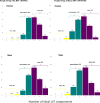Cohort profile: Noncommunicable diseases and ideal cardiovascular health among people living with and without HIV in Zambia and Zimbabwe (NCDzz cohort)
- PMID: 39920050
- PMCID: PMC11808894
- DOI: 10.1136/bmjopen-2024-088706
Cohort profile: Noncommunicable diseases and ideal cardiovascular health among people living with and without HIV in Zambia and Zimbabwe (NCDzz cohort)
Abstract
Purpose: The NCDzz study is a prospective cohort of people living with and without HIV attending primary care clinics in Zambia and Zimbabwe and was established in 2019 to understand the intersection between noncommunicable diseases (NCDs) and HIV in Southern Africa. Here, we describe the study design and population and evaluate their ideal cardiovascular health (ICVH) using the Life's Simple 7 (LS7) score according to the American Heart Association.
Participants: Antiretroviral therapy-naïve people living with HIV (PLWH) and people living without HIV (PLWOH) 30 years or older were recruited from three primary care clinics in Lusaka and Harare, and underwent comprehensive clinical, laboratory and behavioural assessments. All study measurements are repeated during yearly follow-up visits. PLWOH were recruited from the same neighbourhoods and had similar socioeconomic conditions as PLWH.
Findings to date: Between August 2019 and March 2023, we included 1100 adults, of whom 618 (56%) were females and 539 (49%) were PLWH. The median age at enrolment was 39 years (IQR 34-46 years). Among 1013 participants (92%) with complete data, the median LS7 score was 11/14 (IQR 10-12). Overall, 60% of participants met the criteria of ICVH metrics (5-7 ideal components) and among individual components of the LS7, more females had poor body mass index (BMI) than males, regardless of HIV status (27% vs 3%, p<0.001). Our data show no apparent difference in cardiovascular health determinants between men and women, but high BMI in women and overall high hypertension prevalence need detailed investigation. Untreated HIV (OR: 1.36 (IQR 1.05-1.78)) and being a Zambian participant (OR: 1.81 (IQR 1.31-2.51)) were associated with having ICVH metrics, whereas age older than 50 years (OR: 0.46 (IQR 0.32-0.65)) was associated with not having ICVH metrics.
Future plans: Our study will be regularly updated with upcoming analyses using prospective data including a focus on arterial hypertension and vascular function. We plan to enrich the work through conducting in-depth assessments on the determinants of cardiovascular, liver and kidney end-organ disease outcomes yearly. Additionally, we seek to pilot NCD interventions using novel methodologies like the trials within cohorts. Beyond the initial funding support, we aim to collect at minimum yearly data for an additional 5-year period.
Keywords: Cardiovascular Disease; EPIDEMIOLOGIC STUDIES; HIV & AIDS; Risk Factors.
© Author(s) (or their employer(s)) 2025. Re-use permitted under CC BY-NC. No commercial re-use. See rights and permissions. Published by BMJ Group.
Conflict of interest statement
Competing interests: None declared.
Figures




Similar articles
-
Metabolic syndrome among treatment-naïve people living with and without HIV in Zambia and Zimbabwe: a cross-sectional analysis.J Int AIDS Soc. 2022 Dec;25(12):e26047. doi: 10.1002/jia2.26047. J Int AIDS Soc. 2022. PMID: 36522287 Free PMC article.
-
Prevalence of diabetes mellitus and hypertension in people living with human immunodeficiency virus on antiretroviral therapy in Gweru district, Zimbabwe.Afr J Prim Health Care Fam Med. 2020 Aug 11;12(1):e1-e6. doi: 10.4102/phcfm.v12i1.2473. Afr J Prim Health Care Fam Med. 2020. PMID: 32787407 Free PMC article.
-
Liver steatosis and metabolic dysfunction-associated fatty liver disease among HIV-positive and negative adults in urban Zambia.BMJ Open Gastroenterol. 2022 Jul;9(1):e000945. doi: 10.1136/bmjgast-2022-000945. BMJ Open Gastroenterol. 2022. PMID: 35831020 Free PMC article.
-
Correlates of Blood Pressure Awareness, Treatment, and Control Among Adults 50 Years or Older by HIV Status in Northwestern Tanzania.Curr Hypertens Rep. 2022 Aug;24(8):259-266. doi: 10.1007/s11906-022-01188-3. Epub 2022 Apr 6. Curr Hypertens Rep. 2022. PMID: 35384578 Free PMC article. Review.
-
Integrated chronic care models for people with comorbid of HIV and non-communicable diseases in Sub-Saharan Africa: A scoping review.PLoS One. 2024 Mar 15;19(3):e0299904. doi: 10.1371/journal.pone.0299904. eCollection 2024. PLoS One. 2024. PMID: 38489252 Free PMC article.
References
MeSH terms
Grants and funding
LinkOut - more resources
Full Text Sources
Medical
Miscellaneous
